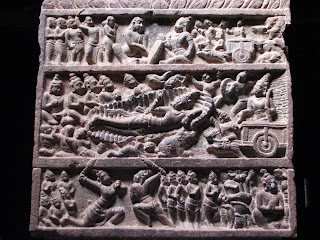Bhishma on a Bed of Arrows.
The area consisting of Aihole, Pattadakkal and Badami served as a crucible of temple architecture during the reign of Chalukyas.
The picture below is one of the many scenes sculpted on the pillars of the Virupaksha temple at Pattadakkal, Karnataka. The Virupaksha temple was built by Queen Lokamahadevi in AD. 745 to commemorate her husband, Vikramaditya II ‘s victory over the Pallavas.. The temple resembles the Kailashnatha temple in Kanchi which served as a model for this temple. The Virupakhsa temple in turn served as an inspiration for the Kailashnatha temple at Ellora (Cave 16) by the Rashtrakuta.

Bhishma or Bhishma Pitamaha was the grand old man of Mahabharata. He was the grand sire who was respected by both the Kauravas and the Pandavaas. Due to circumstances, he had to fight along with the Kauravas in the Kurukshetra war against the Pandavas. Though physically he was with the Kauravas, his heart was with the Pandavas. Yet he discharged his duties as Commander of the Kaurava forces creditably.
Bhishma’s original name was Devavrata and he was the son of King Shantanu and Ganga . His father wanted to marry a fisherwoman, Stayavati, who insisted that only sons born to her should succeed Shantanu to the throne. To facilitate this, Devavrata took a vow of celibacy for life and also pledged to serve anyone who ascended the throne of Hastinapura. Due to this stringent vow, he came to be known as ‘Bhishma’. His father also gave him the boon of ‘Ichcha Mrityu’- the ability to choose one’s time of death.
Even on the tenth day of the battle of Mahabharata, the Pandavas are unable to make any headway., mainly due to the skill and valour of Bhishma. At this point, Shikhandi, who was born a woman, takes arm in front of Arjuna against Bhishma. Bhishma knew that Shikhandi was born a woman, who had a grudge against Bhishma because he had interfered in her marriage. Seeing Shikhandi, Bhishma refused to fight and is felled by Arjuna’s arrow. (It is believed that Bhishma himself had hinted at this ploy while Arjuna and Krishna met him the previous night.)
Arjuna’s arrows had already formed a bed and Bhishma did not fall to the ground. Arjuna used more arrows to form a pillow. Bhishma also requested for water. Arjuna sent an arrow into the earth and a fountain of pure water sprang up which Bhishma relished as Mother Ganga jal. Bhishma also advised Duryodhana to give up the fight and render justice to the Pandavas. Duryodahana did not comply.
As the battle raged, Bhishma held on till Uttarayana (winter solstice) – the auspicious time to die. Only after the victory of Pandavas did Bhishma breathe his last.
It is during his lying on the bed of arrows (called ‘Shara Shayya’) that he composed the Vishnu Sahasranamam- a prayer comprising the 1008 names of Lord Vishu which is recited in many Hindu homes, temples and religious occasions.
There is also a sculpture of Bhishma on a bed of Arrows in Angkor Vat. A beam of sunrays fall on the image of Bhishma on Winter solstice. http://www.clas.ufl.edu/users/vasu/cambodia/angkorwat/bhishma2.html
The mind of Bhishma is beautifully penned in the Bengali poem ‘ Bhishma’s Bed of Arrows’ by Jatindra Mohan Sengupta. A transcreation in English by Pradip Bhattacharya is available at: http://www.indiastar.com/bhattachaya4.html
More pictures at: http://www.flickr.com/photos/shutterbug_iyer/
and
http://community.webshots.com/user/harisub
Dear Professor Subramanian,
ReplyDeleteI am a doctoral student at IDC,IIT Bombay investigating 'Static Visual Narrative'i.e. viusals that tell stories but lack physicaly dynamism.
I am preparing a paper entitled 'On Defining Visual Narratives', to be published in 'Design Thoughts'(the design and research publication from IDC).
I would like to use one of the photos you have posted on your blog - 'Ravana Shaking Kailash, a pillar in Virupaksha Temple, Pattadakkal' as an example of a visual narrative. I would be grateful if you would grant me permission to use the image. It is understood, of course, that full acknowledgment will be given to the source.
Your prompt consideration of this request would be greatly appreciated.
Yours faithfully
Sherline Pimenta
I am sorry to post the letter here but i was unable to locate your email.
ReplyDeleteHere is the link to my work in case you would like to know more:
http://www.idc.iitb.ac.in/students/phd/Sherline_P.html
you can write to me at
sherline@gmail.com or sherline_1@iitb.ac.in
See Ms Pimenta's paper on visual narrative at: http://www.idc.iitb.ac.in/resources/dt-aug-2010/On%20Defining%20Visual%20Narratives.pdf
ReplyDelete